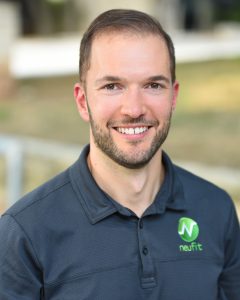The electrical stimulation of muscles was a large part of Dr. Terry Wahls’ recovery after years of steady decline with Multiple Sclerosis. Today she uses Neufit’s Neubie device as a vigorous part of her daily workout and rehab program.
In this interview, she and Garret Salpeter, the founder of Neufit, discuss neuro-plasticity or the ability of the nervous system to adapt, remodel, restructure and reorganize based on environmental inputs—both good and bad.
Neufit is a Wahls Protocol® Seminar Sponsor and Garett will be a featured speaker at this year’s virtual event. Learn more and sign up for virtual access to this new, interactive virtual experience.
Read The Interview Transcript Here:
Dr. Terry Wahls:
Garrett, I am so excited to see you. I think everyone knows I am a huge fan of electrical stimulation of muscles that, that was a big part of my recovery. And then I had stopped doing E-stim for a while, the basis of some recommendations from my medical team and I started having a lot more trouble with back pain. And so, I was thrilled when we met, you got me back doing my E-stim and having that be a very vigorous part of my daily workout and rehab program. So, I’m thrilled to partner with you and thrilled to have discovered you. Garrett, can you tell my tribe a little bit about who you are and what your company, the NeuFit company?
Garrett Salpeter:
Absolutely, yes. And first of all, thank you so much for having me on here. It’s an honor and a privilege to be able to work with you and I’m very excited to be able to present as part of the seminar that now virtual seminar. And it’s just been a real honor because I think that the work that we’re doing compliments so well the work that you’re doing.
I look at it from the perspective of when you’re helping someone who has MS or other autoimmune or degenerative diseases, when you’re helping them stop the progression of that disease, that’s amazing. That is such a gift, that’s so beautiful and wonderful and valuable. And then we also have to talk about what we can do to help once the progression has stopped, what we can do to help regain and restore function that had been lost because of the disease. And so, that’s where we come in.
It’s an addendum, albeit I think a valuable one and it’s an addendum to what you’re doing. And so, I think the synergy is awesome and thank you for the wonderful work. I’ve gotten to read the second revised version of The Wahls Protocol. I read some of that and I love it.
So in terms of what, what we’re doing, NeuFit stands for neurological fitness and we work a lot with the nervous system because the nervous system is this common thread throughout all of these processes, early stage rehabilitation for people who are recovering from orthopedic injuries or chronic pain or trying to restore function after having lost function because of something like MS, that early stage we have all the way through, methodically and safely and step-by-step ramping up the level of challenge to return to activities of daily living or return to the athletic field or whatever someone’s goals are all the way through building a sustainable longterm fitness program or working towards elite performance, whether that’s physically, cognitively, or whatever aspect life. That nervous system is the common thread throughout.
And we believe that working with the nervous system is the most powerful way, the most transformative way to help people recover from pain and injury and set themselves up for success and longterm fitness and health and wellness. And so everything that we do, we have this neurological lens. And of course, I don’t think we have to convince people in your community here that the nervous system is important when you’re talking about a neurodegenerative disease like MS. And so, it happens to be an area of application where this work can be very powerful.
And so, our work is based on functional neurology, based on leveraging and applying the new findings from neuroscience in the last decade or two. And combining that with direct current technology, which also allows us to leverage and take advantage of the new technology that’s come about in electronics.
A couple of decades ago, we couldn’t get high enough therapeutic levels of direct current into the body without burning the skin. And so, now there’s new components and ability to generate signals and things like that, that allow us to do this. So, it’s the combination of … Oh, go ahead.
Dr. Terry Wahls:
And direct current is more physiologic than alternating current. It’s a better match to what my nervous system would normally use. Is that understanding correct, Garrett?
Garrett Salpeter:
That’s correct. That’s correct. So, there’s certainly … Well, let me back up a second. Virtually everything that’s out there in the electrical stimulation world is alternating current, and so having a device that’s direct current is different and understanding some of the contrasts there I think is important where alternating current, there’s some benefit in that you can cause muscles to contract, have a little bit of activity, pump or get some lymph moving, blood flow, things like that.
However, when you turn it up to a high enough level to really make a difference, you run into some challenges, where as that signal alternating means that signal volleys back and forth like this as opposed to direct only goes in one direction. And so, as that signal volleys back and forth, you create this environment where in the muscles of the body start to fight against each other.
And so, it’s like if you were driving your car hitting the throttle and the brake pedal at the same time and you end up training the muscles to stiffen and shorten and become less efficient. Whereas when you have this direct current signal only going in one direction, it matches, as you said, it’s more physiologically appropriate and relevant for the body and it allows us to program more specifically contraction or relaxation, and to stimulate the exact sensory pathways in the nervous system so that we can have a much more significant impact in the realm of neuromuscular reeducation, which is where we’re talking, where we’re working if we’re trying to help someone restore function and take advantage of neuro-plasticity in order to make longterm changes.
Dr. Terry Wahls:
Okay. Excellent. Excellent. You have seen some remarkable improvements in the MS community in other neurological diseases using your NeuFit device?
Garrett Salpeter:
We have, yeah. Particularly in the MS community, we’ve seen some people, well, virtually everyone that we’ve worked with has made some progress. For some people it’s amazing life changing. For some people it’s slower and progress comes more incrementally, but virtually everyone has at least seen some progress. So, it’s been very exciting.
We’ve seen some people restore sensation in their hands and feet. We’ve seen some who have had drop foot, be able to lift their foot again and walk without tripping or without scuffing their foot. We’ve seen some, and then the more dramatic and we’ve seen some who had been in wheelchairs start being able to walk again either with a walker or with support or even some on their own. So, there’s been some dramatic examples. And then there’s been some, where people have made a few percentage points of improvement and yet that’s still helped them with their quality of life.
Dr. Terry Wahls:
Correct. Now, the more advanced the disease with MS, we anticipate steady rates of decline, particularly once you get to needing a cane walker, wheelchair. The clinical course is steady decline unless we’re able to stop the inflammation neurodegeneration. And that’s one my tenants who I teach in the Wahls Protocol use diet and lifestyle to try and stop the damage. And then the next process that I talk a lot about is the process of rebuilding that takes time to reeducate the muscles, rebuild the muscles, rebuild that nervous system.
And I talk about in my book that electrical stimulation can support and speed that process. Now, it’s not magic that it will fix the nervous system without effort. Can you speak to that Garrett? If I just hook everyone up to your device, can they just lay there and that will magically fix them or do they have to do some work too?
Garrett Salpeter:
Definitely, we have to meet in the middle. There’s definitely some active participation and some work. And there’s a few points here that I think are helpful in addressing this topic. In terms of, as you’ve mentioned, oftentimes the trend is for further progression and for function to diminish and continue to get worse over time. So, there’s a few principles that I’ll preview here and we’ll dive into more deeply in the talk that I’ll give as part of your seminar series. And, there’s a few principles here.
So, there’s neuro-plasticity describes the ability of the nervous system to adapt and remodel and change and restructure and reorganize based on the activities that we’re doing based on environmental inputs. And that can be good or bad, so we’re always adapting to whatever we’re doing. So, if we get stronger like muscles, if we use our muscles in the gym, they can get bigger. So too, if we challenge our nervous system, can it get stronger and more robust, reorganize, build new pathways, remyelinate some pathways, there’s documented evidence that the nervous system can upgrade and that’s what we want to tap into.
However, it can also get worse. Adaptation works in both directions. So, in the typical everyday world, we see, for example, an example of a “negative” adaptation, think about the office worker who’s hunched over at their desk for eight hours a day. They do that day after day after day, and they get so good at that, that they’ve adapted to it. And they’ve actually earned the right to be in that position all day long, even when they get up from their desk. So the of adaptation, it doesn’t discriminate good or bad, adaptation is something that happens in response to whatever it is that we’re doing.
And so, one of the challenges that people face with neurodegenerative diseases or neurological injuries like stroke or spinal cord injury, is that there’s an adaptation called learned disuse, where if you can’t use an area of your body or you can’t use it as effectively, your body’s going to adapt to not using it, and take neurological resources, whether it be brain space or neurological connections that were feeding that area, it’ll actually take them away. It’ll repurpose them to use at another area.
And so, it amplifies the notion that if you don’t use it, you lose it where if you can’t use it, then you’re going to lose it even faster. And so, there’s a downside to neuro-plasticity as one component of this. And then also in terms of the positives of neuro-plasticity, what we need are a significant volume of work. We need to challenge whatever neurological pathways we’re trying to stimulate.
If one is not able to lift his or her foot because of drop foot, we need to stimulate the nerve pathways that trigger that, that initiate that movement. And in order to reactivate that, it takes a lot of input. It might take hundreds of thousands of repetitions of correct movement in order to stimulate the body to actually invest the resources longterm to reorient new brain areas or make new pathways or lay down myelin on some of those existing pathways, whatever the adaptation is.
And it’s very difficult to accumulate that amount of work, that number of repetitions. And that is where as you said, technology like this can come in to help make that process more efficient and shorten the overall process or make it possible at all. Because if you can’t do that movement, then how on earth are you going to a mass hundreds of thousands of reps, you can do some visualization practice like that, but you can’t actually get the number of reps that you need. And so that’s where a tool like this comes in because it allows us to send that signal in a very, very powerful way and consistent way and do it frequently enough over time so that we can accumulate that overall volume of work.
Dr. Terry Wahls:
I am so impressed with the power of electrical stimulation to change the trajectory of strengthening and rehab. What I find exciting Garrett is now other scientists are agreeing with me and there’s more research being published about the use of E-stim, even in people who have a significant disability who have very little walking. There are now studies talking about hooking these people up to E-stim, and working with them to improve their function and their quality of life. Wonderful stuff.
Now, I know I’m thrilled that you’re going to be speaking at our seminar. Can you give us a little sneak preview of what that, excuse me, of what you’ll be talking about and what topics you’ll be covering?
Garrett Salpeter:
Yes, absolutely. So, neuro-plasticity is definitely the theme, and we’re going to talk more in depth about those pros and cons of neuro-plasticity. And, it’s what I hope to be and what I believe will be a very empowering message because we’re going to lay out the scientific case for how and why the body can and will reorganize and adapt to help improve function. And we’re going to lay out a path and what the prerequisites are in order to regain function that has been lost.
And again, it can be a range of from here to here for different people and we’ll talk about the factors that influence that and what people can be doing, the actionable items, whether it’s working with us or even otherwise. We’ll lay down the actionable items that people can take to increase their opportunity for neuro-plasticity.
Dr. Terry Wahls:
We give a discussion about … Because people have heard about the TENS Units electrical and there are a number of electrical therapy devices. Will you be talking about that at all in your talk? And if not, then I’ll make sure that I cover that in my talk. So you and I have to make sure we each understand who’s covering what in our respective talks.
Garrett Salpeter:
Yes. I’ll talk some at least at a high level about E-stim and generally about different strategies that are being used for neuro-plasticity outside of electrical stimulation and electrical stimulation and some of those differences between TENS Units and more traditional E-stim, and then the approach that we’ve taken to bring that to the next level.
Dr. Terry Wahls:
Excellent. Another thing that I’m hearing from so many people in the public is, they’ve read my book, they’re fired up now about E-stim, they’re fired up about electrical therapy, but they struggle mightily to find anyone in their community who can give them any support or guidance or insight in how to incorporate that into their current exercise program or how to access that. That’s frustrating. It’s also why I’m so excited to see that you’re out there training physical therapists on how to add this very helpful modality to the rehab program. So, I want to give a lot of thank you to you, Garrett. It’s just so important that we get more physical therapists trained and excited about the using E-stim as part of the rehab.
Garrett Salpeter:
Absolutely. And I talk, now I’m blessed to be able to interact with hundreds and hundreds or thousands of physical therapists and some have preconceived notions about E-stim, because they’re used to the more traditional modalities and they see that they don’t have as much value and they’ve gone away from them. And some of them are concerned, some of them are concerned that it doesn’t work. Some of them are concerned that it either interferes with or somehow is an artificial way of working with someone as opposed to hands-on techniques or things that require more skill from them.
And when we’re able to communicate to them that one, we’re not taking the place of anything physically, we’re actually just using this to help tap into the body’s potential that it has there and trigger the body to actually do the work. And when they realize that they can use it and in a way that’s very complimentary to their other exercise or manual techniques and therapies, they’re becoming more and more receptive to it. And so, we definitely, definitely want to, as you said, there’s a real need particularly in the MS community and we definitely want to get the word out.
Dr. Terry Wahls:
Yeah. There’s a huge need. Well, we’re working on training practitioners how to use the Wahls Protocol, we’re trying to get more and more physical therapists fired up about E-stim and how to incorporate that in their clinical practice. I’m very thrilled to support Garrett as he’s working to train the therapist community as well.
So Garrett, I’m thrilled to have discovered you. I’m thrilled to partner with you, and I’m also thrilled to support you as you train your practitioners. If there’s any way that we can support that effort, of course do reach out.
Garrett Salpeter:
Thank you Dr. Wahls and we’re delighted to work with you as well. Thank you.
Dr. Terry Wahls:
Now, we’ll put some links up below this in terms of how to reach NeuFit and to sort out if you have NeuFit in your community. They have a wonderful device and they have really partnered very well with the therapy community about how to incorporate E-stim in physical therapy to accelerate your rehabilitation potential. Love you, Garrett. I look forward to seeing you soon.
Garrett Salpeter:
Love you too. Thank you.
Neufit is a Wahls Protocol Seminar Sponsor and Garrett will be contributing to the virtual event with a more in-depth talk on Neuro-plasticity.
Learn more about Neufit and the Neubie device at neu.fit If you are a P.T., Chiropractor, or other medical professional and you use any manual therapy or corrective exercise—upgrade your practice and partner with Neufit. Be a part of their certification and mastermind-like community. Apply today at https://www.neu.fit/professional

About Garrett
Known as “The Health Engineer,” Garrett has taken his education in Physics (BS) and Engineering (MSE) and applied it into a system for making the human body better. His journey started when he picked up ice hockey as a boy. It was a game he loved, but for which he had little natural aptitude. After several years “skating by,” he decided to delve deeply into the world of strength and conditioning to try to give himself a chance to play at a higher level. Unfortunately, what was popular at the time did not work for him — and he kept searching.
In dealing with some injury problems, he learned about the paramount importance of the nervous system, and saw the connections to how the same neurological principles could be applied to fitness. The neurological approach worked, and he never looked back. He became determined to learn as much as possible about how to affect the nervous system. To that end, he spent hundreds of hours in self-study, mentored under several leading-edge practitioners, tested many of his theories on himself and others, and even went back to school for a Ph.D. program in Neuroscience (from which he took a leave of absence to launch the Neubie device).
In 2009, he opened his first facility in Austin, TX to start sharing these methods with his community. This has grown into what we now know as NeuFit, which combines an advanced understanding of physiology with the best practices from diverse training and therapeutic practices, and constantly pushes these processes by using technology to accelerate them further. Since that first day, he has worked with people of all ages and in almost all situations, including athletes from MLB, the NFL, the NHL, the NBA, UFC, Olympics, NCAA, and more, helping them get out of pain, improve performance, sometimes avoid surgeries, and live life at a higher level.
He lives in Austin, Texas and is ecstatically in love with his wife, Briana, and their two daughters, Gwenny and Gemma.




